Try Default

See how revenue teams automate revenue operations with Default.

Key Takeaways
Key takeaways
- Sales efficiency shows how effectively your team turns sales and marketing investment into revenue. It’s measured as a ratio — with 1.0 as breakeven, and anything above that signaling efficient growth.
- There are multiple ways to calculate it: basic, gross (new ARR only), and net (including expansion and churn). Each offers a different lens on performance.
- Improving sales efficiency is about reducing friction, not just increasing activity. Tighter ICP focus, shorter cycles, better enablement, and smarter automation all drive measurable gains.
- Default helps remove the biggest blockers to sales efficiency — poor data, slow routing, and low-context handoffs. When reps start with complete context, they close faster and waste less.
Sales teams today face a clear challenge: drive more revenue with fewer resources. Budgets are tighter. Headcounts are leaner. Timelines are shorter.
That’s why sales efficiency has become a critical metric. It answers the question: Are you getting maximum revenue for every dollar spent on sales and marketing?
In this guide, we’ll break down what sales efficiency is, how to calculate it (with simple examples), and the most effective ways to improve it. Whether you run a SaaS company, service business, or product-based operation, these strategies will help you improve performance without increasing costs.
Let’s start by simplifying the definition.
Sales efficiency explained in simple terms
Sales efficiency tells you how effectively your business turns sales and marketing spend into revenue. It’s a ratio — not a raw number — and it helps you measure the return on your go-to-market investments.
A sales efficiency ratio above 1 means you’re generating more revenue than you’re spending. Below 1? You’re likely overspending to hit growth targets.
It’s a fast way to see if your sales engine is performing — or simply burning budget.
Why optimizing your sales efficiency is important
Sales efficiency is a leading indicator of scalable, capital-efficient growth. Improving it doesn’t just cut waste — it tightens execution, shortens ramp times, and drives more predictable revenue outcomes.
Lower customer acquisition costs (CAC)
A more efficient sales process means fewer wasted calls, shorter cycles, and better-qualified leads. By streamlining outreach and focusing on segments with high intent, you reduce spend per closed deal. This not only protects margins but creates room to reinvest in more effective acquisition channels — without inflating your CAC.
Faster payback periods
High sales efficiency shortens the time between customer acquisition and breakeven. When reps close faster and onboard customers who convert quickly, revenue returns sooner. That means you free up working capital faster, improve cash flow, and reduce the financial risk associated with each new customer.
Smarter capital deployment
Sales efficiency ratios reveal which parts of your GTM motion are pulling weight, and which aren’t. With a clear view into ROI by segment, channel, or rep, you can make informed budget cuts or double down on proven strategies. That discipline becomes a competitive advantage as you scale.
More consistent revenue performance
Efficient teams waste less time chasing the wrong deals and more time building qualified pipeline. That leads to shorter, more reliable sales cycles, higher conversion rates, and fewer surprises in forecast accuracy. In short: sales becomes more predictable — and easier to scale without constantly hiring or spending more.
Together, these improvements create a compounding effect: reduced acquisition costs, faster payback, and steadier revenue. Sales efficiency helps you spot where momentum is building — and where growth is being dragged down by hidden friction.
Calculating sales efficiency
Sales efficiency is typically expressed as a ratio: revenue generated divided by the cost to generate it. Depending on your sales model, there are a few variations worth tracking — each offering a slightly different view of how efficiently your team is converting investment into revenue.
Basic sales efficiency formula
This is the most straightforward version:
Sales Efficiency = Revenue / Sales & Marketing Costs
If you spent $100K on sales and marketing last quarter and brought in $200K in revenue, your ratio is 2.0. That means you're generating $2 for every $1 spent — a strong sign of efficient execution.
Gross sales efficiency
Gross sales efficiency focuses only on new revenue from new customers, ignoring expansion or upsell.
Gross Sales Efficiency = New ARR / Sales & Marketing Spend
It’s a useful benchmark for understanding how well your team is acquiring fresh pipeline. For example, $50K in new ARR from $100K spend = 0.5 gross efficiency — not ideal.
Net sales efficiency
Also known as the Magic Number in SaaS, this version includes expansion, upsell, and churn.
Net Sales Efficiency = Net New ARR / Sales & Marketing Spend
Say you added $60K in expansion and lost $10K to churn, for a net gain of $100K. If you spent $100K on sales and marketing, your ratio is 1.0 — meaning your net revenue covered your spend.
Keep in mind: product-led companies, enterprise sales teams, and services firms may calculate sales efficiency differently. But the goal is the same — tie revenue outcomes directly to GTM inputs.
Best practices to increase sales efficiency
Effective sales efficiency isn’t about speed for its own sake—it’s about removing friction so your reps can do what drives revenue. These tactics spotlight bottlenecks, align behavior to outcomes, and amplify every dollar invested in your GTM engine.
Tighten your ICP and lead qualification
One of the fastest ways to boost efficiency is to get ruthless about who enters your funnel. Refine your ICP using real conversion data, not just firmographics. Then align sales and marketing on qualification criteria so reps spend less time chasing unqualified leads and more time with accounts that will close.
Shorten and standardize the sales cycle
Audit your pipeline to identify stages where deals stall or drop off. Are handoffs breaking down? Is legal slowing things down? Build a consistent sales process with clear exit criteria for each stage, so every rep moves deals forward the same way and bottlenecks can be addressed early.
Invest in sales enablement and onboarding
Efficient teams don’t just ramp faster — they ramp smarter. Iron Mountain reduced ramp time by three months after using Gong to spot the talk tracks and behaviors that correlated with quota attainment. Structured onboarding, backed by data, turns best practices into team-wide habits.
Automate low-value tasks
Admin work eats into selling time. Automate lead routing, activity logging, follow-up emails, and reporting wherever possible. Even small time savings across daily sales workflows add up — freeing reps to focus on what actually moves the needle: conversations, demos, and closing deals.
Use data to optimize rep performance
Look beyond closed-won to understand what top performers are doing differently. Are they qualifying faster? Running more discovery calls? Use those insights to coach the behaviors that improve conversion efficiency at each stage, not just the end result.
Pro tip: longer, personalized demos improve win rates
BlackLine saw a 54 % increase in win rate after deploying Consensus-powered personalized demos and pre-demo qualification boards. When buyers feel understood—before a call—they’re far more likely to engage meaningfully in the live interaction.
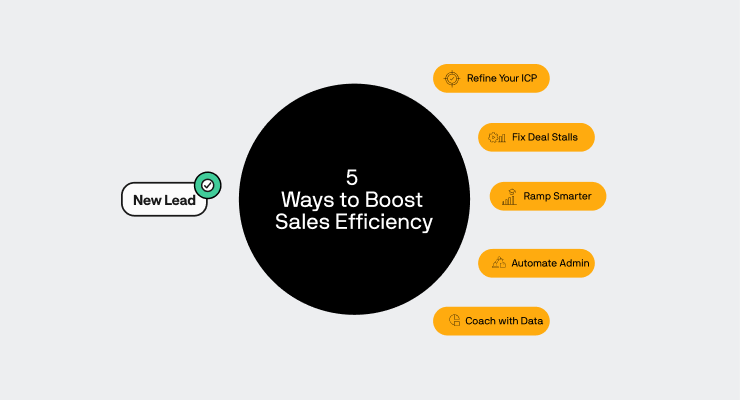
Key metrics that influence sales efficiency
Sales efficiency is only as strong as the inputs driving it. These metrics provide early signals about whether your GTM motion is scaling profitably — or silently leaking value.
Customer acquisition cost (CAC)
CAC is the total cost of acquiring a customer, including sales and marketing spend. If your efficiency ratio is low, CAC is often the culprit. Segment this by channel, persona, or deal size to identify where costs are creeping up and reallocate budget accordingly.
Lifetime value to CAC ratio (LTV:CAC)
This metric tells you how profitable your customers are over time relative to what it cost to acquire them. A ratio of 3:1 is often cited as healthy, but the key is trend direction — if your LTV:CAC is declining, efficiency gains elsewhere won’t be enough.
Sales cycle length
Longer sales cycles don’t just delay revenue, they inflate acquisition costs and reduce rep capacity. Measuring time-in-stage helps you pinpoint where deals are stalling, while trimming cycle length often produces a compound gain in both conversion efficiency and forecast accuracy.
Payback period
This is how long it takes to recoup your CAC. A shorter payback means less cash is tied up in acquisition, freeing you to reinvest faster. If your payback period is creeping past 12 months, it’s a red flag that sales efficiency — or retention — needs attention.
Together, these metrics give you the operational visibility to act early — before inefficiencies scale with your headcount or budget.
Sales efficiency ratio targets
Sales efficiency ratios aren’t just performance snapshots — they’re indicators of how sustainably you’re growing. Here’s how to interpret the numbers and where to adjust based on what they reveal.
- Above 1.0 — You're generating more revenue than you’re spending. A strong sign your sales engine is working efficiently. Look for areas to double down or scale.
- 1.0 — Breakeven. You’re covering your acquisition costs, but there’s no margin for error. Small improvements in cycle time or conversion rate can tip the ratio in your favor.
- 0.5–0.9 — Efficiency issues are likely. You're spending more than you're earning from those efforts. Time to audit your GTM spend, rep productivity, and qualification process.
- Below 0.5 — Red flag. This typically points to serious inefficiencies — bloated CAC, stalled deals, or weak close rates. Stop scaling and fix the fundamentals before expanding further.
Note: SaaS orgs often track both gross and net sales efficiency. A gross ratio >0.75 and a net ratio >1.0 are healthy baselines, but they vary by model and maturity stage.
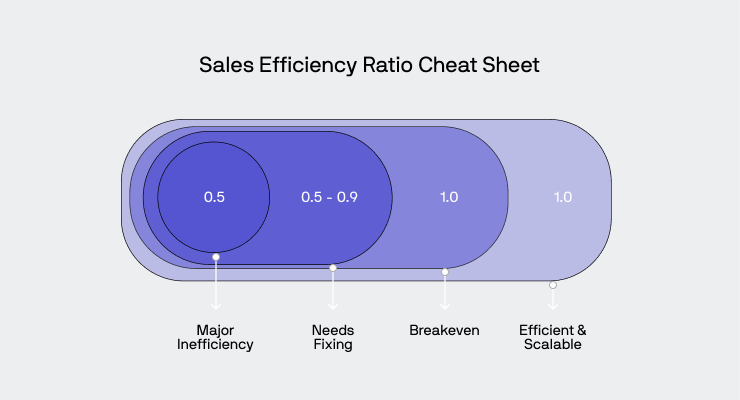
Common mistakes that hurt sales efficiency
Even high-performing sales orgs leave money on the table by overlooking key friction points. These are some of the most common — and costly — mistakes.
Chasing volume instead of fit
Filling the top of the funnel with poorly qualified leads might boost activity metrics, but it kills downstream efficiency. Reps burn time on bad opportunities, conversion rates tank, and CAC climbs. Efficiency starts with focus, not volume.
"Time is the most precious resource for every salesperson, and that’s why they need absolute clarity about their Ideal Customer Profile (ICP)."
— Tony Hughes, Managing Director, RSVPselling
Overcomplicating the sales process
Too many stages, approval loops, or handoffs create drag. If your reps need to navigate multiple systems or stakeholders to close a deal, you're not just slowing down the cycle — you’re increasing the likelihood of drop-off.
Underinvesting in rep enablement
When reps don’t have clear messaging, strong onboarding, or timely coaching, performance stalls. This leads to inconsistent execution, longer ramp times, and missed revenue. Enablement isn’t a support function; it’s a core efficiency driver.
"Sales enablement can’t be reactive. It has to be a full-blown strategy that’s woven into the fabric of the company."
— Roderick Jefferson, CEO, Roderick Jefferson & Associates
Ignoring stage-level conversion data
Focusing only on closed-won deals hides where pipeline efficiency is breaking down. Without insight into stage-by-stage conversion rates, it’s hard to know what’s working, what’s stalling, or where to intervene. You can’t improve what you’re not measuring.
Most efficiency gaps aren’t caused by lack of effort — they’re caused by misalignment, wasted motion, and avoidable friction.
The good news? Each mistake here is fixable with better data, tighter focus, and smarter systems.
Essential tools to help improve sales efficiency
Tech can’t fix a broken process — but the right stack can remove bottlenecks, reduce admin load, and surface the insights that drive better decisions. These tools help multiply your team’s output without adding more headcount.
Default

Default helps revenue teams streamline lead enrichment, route high-fit accounts instantly, and give reps the context they need to convert faster. It acts as a multiplier on your existing GTM stack — reducing manual effort and improving every handoff from marketing to sales.
- Auto-enrich leads with firmographic and intent data
- Route inbound prospects based on ICP-fit and behavior
- Surface buying signals and stage-relevant actions for reps
- Eliminate CRM guesswork with clean, enriched records
- Integrates with Salesforce, HubSpot, Marketo, and more
See how Default helps teams close more pipeline with fewer resources. Book your interactive demo.
Gong
Gong captures every customer interaction and uses AI to surface patterns that drive rep performance. Sales leaders use it to accelerate onboarding, coach more effectively, and understand exactly what top reps do differently.
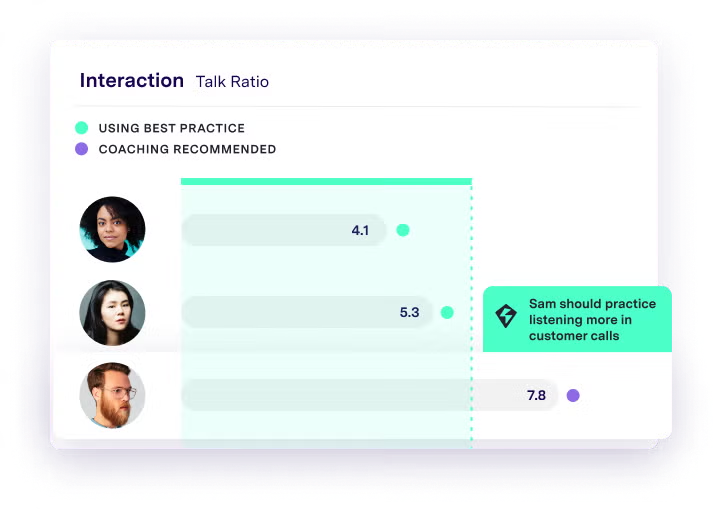
Clari
Clari gives revenue leaders visibility into pipeline health, forecast accuracy, and deal risk. It helps teams identify stalled opportunities, course-correct in real time, and improve sales planning based on actual activity trends — not gut feel.

Dock
Dock helps reps move deals forward with shared workspaces that align buyers and sellers. Reps can track engagement, share tailored content, and build mutual action plans — creating a smoother, more efficient buying experience from first call to close.

Drive smarter sales efficiency gains with Default
If you're serious about improving sales efficiency, fixing pipeline friction isn’t optional — it’s where the biggest gains come from. Most teams lose time (and deals) because lead data is incomplete, routing is manual, and reps are flying blind on context.
Default solves all of that.
It enriches every inbound lead instantly, routes them based on real buying signals, and equips reps with the context to convert faster. That means fewer handoffs lost, less time wasted on bad fits, and a tighter connection between marketing spend and revenue.
See how Default helps revenue teams close more pipeline with less waste. Book your demo today.
Conclusion

Former pro Olympic athlete turned growth marketer! Previously worked at Chili Piper and co-founded my own company before joining Default two years ago.
Accelerate your growth with Default.
Revamp inbound with easier routing, actionable intent, and faster scheduling















.png)


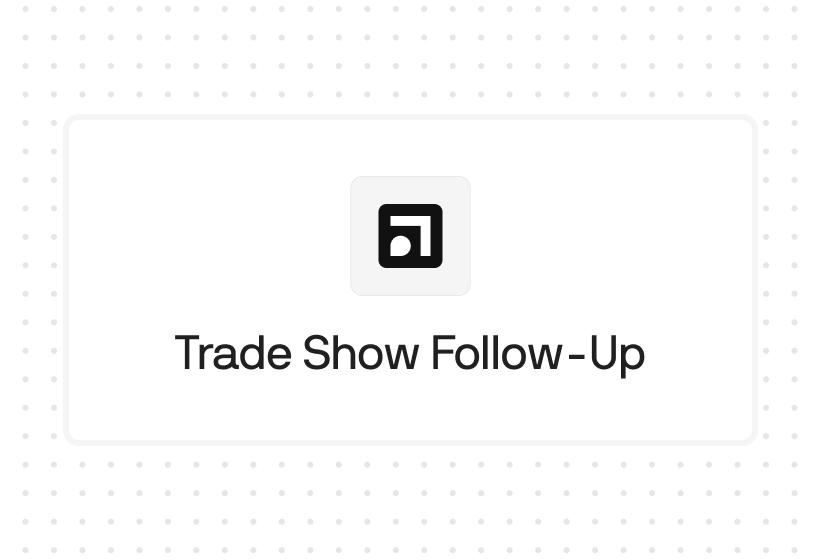
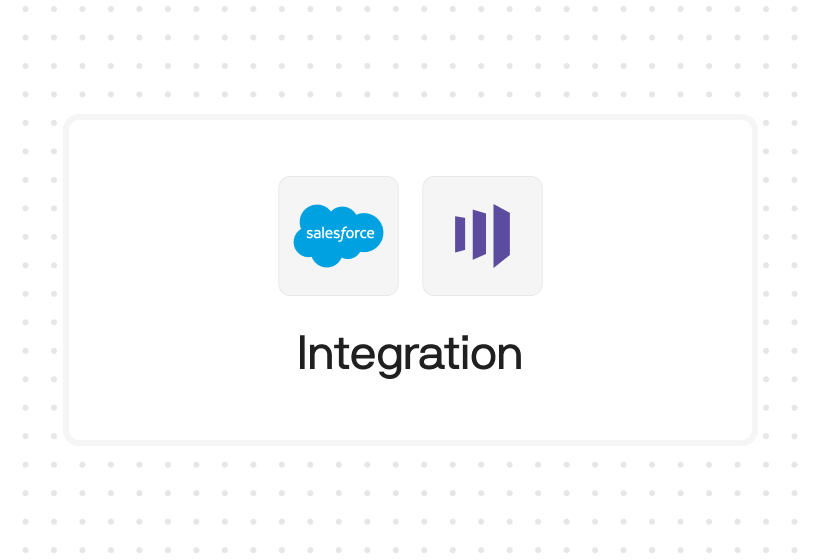




%201.svg)



.svg)





%201.svg)



%201.svg)

